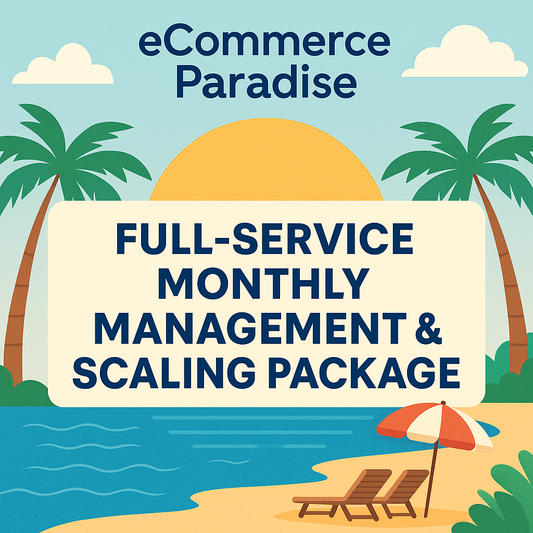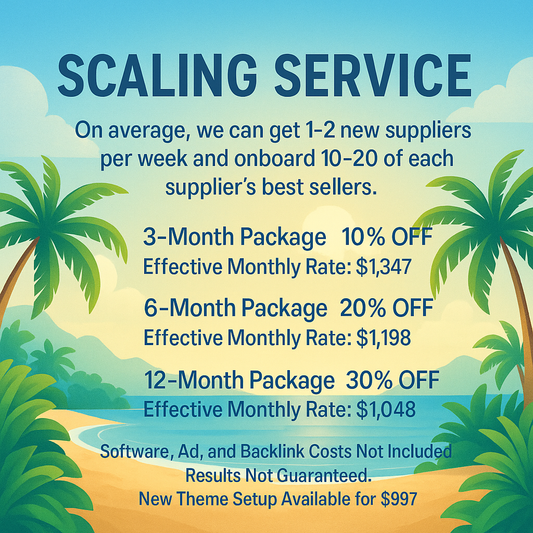
Boost Your Sales: Social Media for High Ticket Products
Hey, eCommerce entrepreneurs! Trevor Fenner here, founder of eCommerce Paradise, and today we’re diving into an exciting and powerful strategy—leveraging social media to promote high-ticket products. With the right approach, social media can turn your followers into dedicated customers, especially when it comes to high-value items. Are you ready to unlock the potential of social media in your dropshipping journey? Let’s get into it!
Why Focus on High Ticket Products?
Before we dive into the social media strategies, let’s talk about why high-ticket products are worth your focus. Selling high-ticket items can significantly impact your bottom line. Here are a few reasons:
- Higher Profit Margins: With high-ticket items, you can make substantial profits from fewer sales.
- Less Stress, More Strategy: Focusing on a few high-value products means less strain in managing a plethora of lower-priced items.
- Customer Lifetime Value: Higher-priced products often come with a more engaged customer base who invest more in their experiences.
If you’re looking for a complete dropshipping solution, targeting high-ticket products is the way to go. Now that we've established the value of high-ticket dropshipping, let’s discuss how to effectively use social media as your promotional platform.
Understanding Your Audience
Social media is all about connection, and to forge those connections, you need to know your audience. Here’s how you can identify and understand your target audience:
Research Demographics
Start by analyzing the demographics of your existing customers and those of your competitors. What are their age, gender, interests, and online behavior?
Create Buyer Personas
Once you have the data, create buyer personas. These are fictional representations of your ideal customers based on real data. Each persona should highlight their needs, motivations, and pain points. This will guide your marketing efforts and content creation.
Choosing the Right Platforms
Not all social media platforms are created equal for every business. While some may thrive on Instagram, others may find more success on LinkedIn. Here’s a breakdown of some effective platforms:
Instagram: Visual Appeal
Instagram excels in aesthetics and visual storytelling. For high-ticket products, eye-catching photos and videos can captivate your audience. Use features like Stories and Reels to create engaging content that showcases the uniqueness of your products.
Facebook: Community Building
Facebook is great for building communities. You can create groups related to your niche where customers and enthusiasts can engage, share ideas, and provide valuable insights. It’s also a powerful platform for customer service and direct sales.
LinkedIn: Professional Networking
If your high-ticket items cater to businesses or professionals, LinkedIn is an excellent place to showcase your products, share articles, and connect with key decision-makers.
Create Engaging Content
The heart of your social media strategy lies in creating engaging, high-quality content. Here are various content ideas and formats to consider:
In-Depth Product Demonstrations
Showcase how your high-ticket products work, their benefits, and why they stand out from the competition. Live demonstrations, tutorials, or engaging video content can provide valuable insights to potential customers.
User-Generated Content
Encourage your customers to share their experiences with your products on social media. This not only acts as a testimonial but also creates a sense of community around your brand. Reposting user-generated content can enhance trust and loyalty.
Behind-The-Scenes Content
Share the story behind your brand and product sourcing. This transparency can build a stronger connection with your audience and present your brand as approachable and sincere.
Leveraging Influencer Marketing
Influencer marketing can be a game changer when promoting high-ticket products. Here’s how you can navigate this space:

Identifying the Right Influencers
Don’t just go for anyone with a large following. Look for influencers whose audience aligns with your target market and who embody the values of your brand. It’s about quality over quantity.
Outreach and Collaboration Plans
Once you have a list of potential influencers, reach out with a clear proposal. Outline how the collaboration can benefit them and their audience. Think creatively about how they can showcase your products—reviews, unboxing videos, or lifestyle shots using your products.
Harnessing Paid Advertising
If you’ve got a budget for it, consider leveraging paid social media advertising to boost your reach. Here’s what to keep in mind:
Targeting the Right Audience
Platforms like Facebook and Instagram offer robust targeting options. You can target users based on their interests, location, and behaviors, ensuring your ads reach your ideal customers.
A/B Testing Strategies
Always experiment with different ad formats, visuals, and messaging. A/B testing is vital for understanding what resonates best with your audience and optimizing your ads for maximum engagement and conversion.
Engaging with Your Audience
Social media isn’t just about posting; it’s also about interaction. Here’s how to engage with your audience effectively:
Responding to Comments and Messages
Make it a habit to respond promptly to comments and direct messages. Address questions, thank your followers for positive feedback, and handle negative comments gracefully. Building rapport with your audience fosters loyalty.
Running Contests and Giveaways
Contests can be a fun way to increase engagement and followers! Consider giving away your high-ticket product to generate excitement around your brand.
Measuring Success and Refining Your Strategy
The key to effective marketing is constantly measuring your outcomes. Here’s what to focus on:
Setting KPIs
Define clear Key Performance Indicators (KPIs) that align with your goals. Are you looking for increased engagement, website traffic, or direct sales? This will help you focus your efforts.
Analyzing Insights and Adjusting
Utilize the analytics tools provided by each social media platform. Analyze the performance of your posts, the demographics of engaged users, and adjust your strategy as necessary. Don’t be afraid to pivot if something isn’t working!
Embracing a Multi-Channel Approach
Don’t limit yourself to just one social media platform. Embrace a multi-channel approach to maximize your reach. Here’s how:
Cross-Promoting Your Content
Use your various social media accounts to share and promote your content. This not only expands your reach but also reinforces your message across multiple touchpoints.
Integrate Into Your Email Marketing
Connect your social media efforts with your email marketing campaigns. Encourage followers to sign up for your newsletter and provide exclusive content to your subscribers. This will create a seamless marketing funnel.
Unlock Limitless Possibilities
As you can see, leveraging social media to promote your high-ticket products can open up a world of possibilities for your eCommerce business. By understanding your audience, creating engaging content, and embracing a strategic approach, you can elevate your brand and boost those sales.
Remember, social media isn’t just a marketing tool; it’s a way to build relationships and foster community. So get out there, share your passion, and watch your business thrive. Happy selling!


















